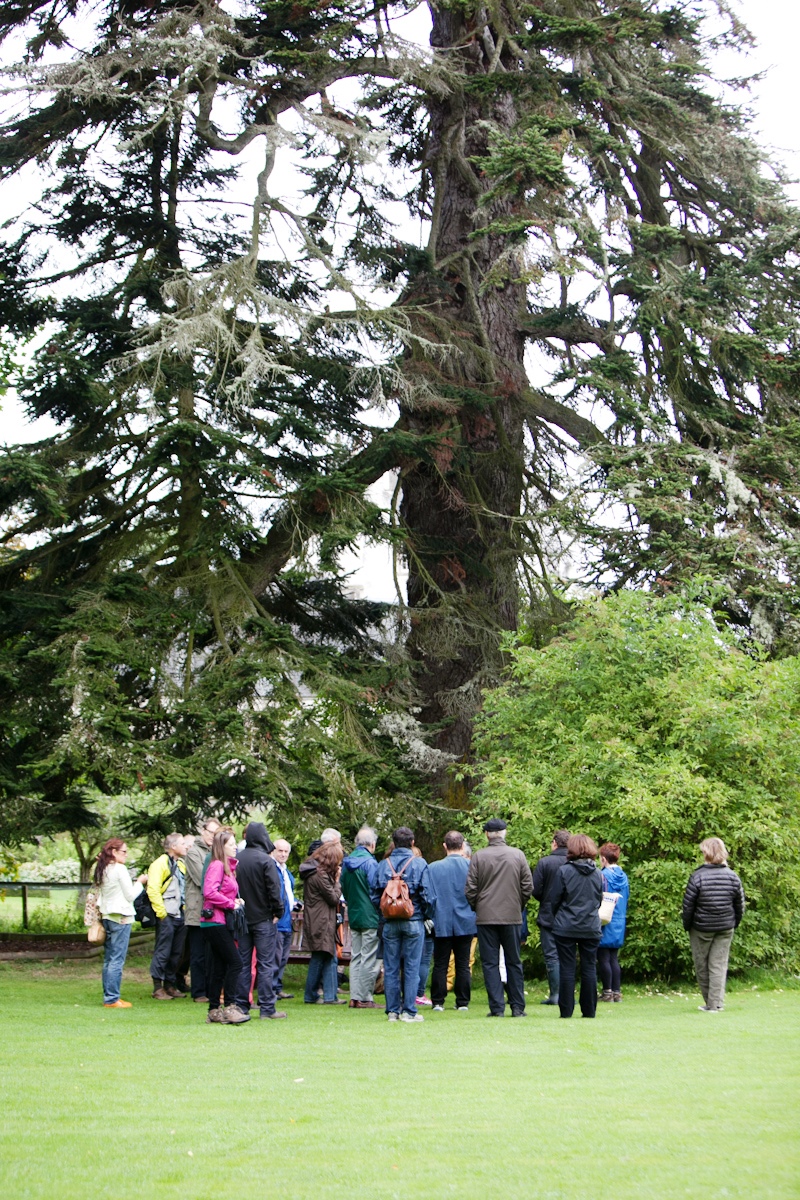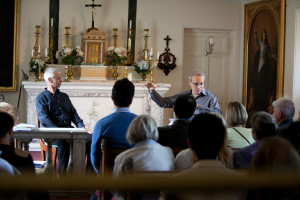
O 4º Libros, Fronteiras e Festival Bikes realizouse na maior vivenda continuamente habitada de Escocia, Traquair Casa en Río Tweed na Scottish Borders. Organizado pola Beyond Borders Escocia é un festival único da literatura e do pensamento que reúne os principais escritores, políticos, soldados, lawyers and artists to discuss topics relevant to international relations Scotland’s role in the world. Two talks “Understanding the Islamic World” and “Iraq Ten Years On: Que leccións para a Siria ea ONU?"Dar testemuño da amplitude do fío. SNSI coordinator, Robert Salvaxe participou dous eventos; un paseo titulado "Se as árbores puidesen falar – o que din?", e unha charla sobre a "Neurociencia do antigo e sagrado sitios naturais".

The group on the trail with Ian Edwards, cabeza de eventos no Royal Botanic Garden Edinburgh, discutir a asociación cultural de árbores, mentres Catherine Maxwell, cuxa familia foi na residencia para 300 anos, dende a historia das árbores. (Photos courtesy Beyond Borders)
A camiñada de domingo de mañá foi "Un Proxecto Ciencia Fala'En colaboración co Royal Botanic Garden Edinburgh. El explotou paisaxe histórica de Traquair e descubriu as historias das súas árbores incribles (www.traquair.co.uk). Ian Edwards, cabeza de eventos no Royal Botanic Garden Edinburgh, dirixiu a charla sobre as historias biogeográficas e asociación cultural de árbores da propiedade, incluíndo Yew, Cal, Silver Fir and Hazel. Catherine Maxwell Stuart, propietario e cuxa familia foi na residencia para 300 anos, dende a historia das árbores.
O grupo rematou con fío no lugar contemplativo creado polos Yews antigas que poden sobrevivir a partir do momento do Bosque ETTRICK agora apurada en que o Traquair House - un pavillón de caza dos reis escoceses desde ao redor de 1107 – was originally been situated. Robert posed that if trees could talk they may have a few questions of us like: O que fixo para ETTRICK Bosque? Que diaños ten feito para a metade dos bosques do planeta? Vostede imaxina que coidar de nós árbores? Really we look after you!
Following the walk the talk took place inside the packed Chapel. Entitled “A neurociencia da antiga e sagrada Sitios Naturais: Ohy lugares antigos evocar unha espera tan poderosa sobre a nosa cultura e debe ser protexido durante momentos de conflito ", the talk explored Sacred Natural Sites and made links to the emerging understanding of Neuroscience.
Robert kicked off saying that Sacred Natural Sites can be described as places where the human mind meets Nature. He observed that the Traquair chapel (que é relativamente nova adaptados para este fin, en 1829) tiveron poucas indicacións da natureza, pero que o máis probable é que todos os espazos sagrados orixinalmente derivado da natureza.
Robert pasou a describir os sitios naturais sagrados e foi por iso que eles gañaron o interese do movemento internacional de conservación. Nature conservation practitioners have a very pragmatic interest in sacred natural sites as they protect a wide range of rare species. This is particularly important as we have now entered the 7º gran evento de extinción, with hundreds of species becoming extinct daily. Beyond this, con todo, sitios naturais sagrados tamén incorporar un conxunto profundo de arquetipos das relacións humanas para que poidamos aprender a definir un camiño máis sustentable para a humanidade.
Un tal concepto é o da 'Santuario' that seems to be a direct import from ancient European sacred groves into the early Christian church. Sanctuary arose in the sacred groves of Europe where, no hunting was allowed and if a hunted animal found refuge in a sacred grove the hunt had to stop. Human fugitives could also find sanctuary in the sacred grove. Many of these provisions still hold in the sacred groves of Africa and Asia. At some point this sanctuary principle transferred into the church.

Before getting into the neuroscience of the sacred, Robert Salvaxe (esquerda) explored sacred sites as potential areas for limiting conflict. (Photos courtesy Beyond Borders)
Finalmente, e antes de entrar na neurociencia do sagrado, Rob focused on sacred sites as potential areas for limiting conflict. Rob presented an example recently shared by colleagues at the Aigine Cultural Research Centre con respecto a 2010 Kirguizistán conflito, onde centos de persoas foron mortas e miles desaloxadas en un conflito entre kirguiz e usbecos no sur do país. Moitos dos habitantes desprazados atoparon refuxio nun lugar sagrado para ser un porto seguro en tempos de conflito:
"Kamchieva Mopasha as novelas uzbeques étnicos e 'shaiyks'Ou gardián do local estados: “Cando hai un desastre, as persoas veñen a este santuario e atopar refuxio ". According to her, no auxe do conflito en xuño 2010, [moita xente] fun alí tanto kirguiz e uzbeques, pero eles non estaban preguntando quen é quen, [pero] xuntos ofreceu un sacrificio a Deus, pedindo a restauración da paz ea harmonía. Moitos peregrinos quedara para os dous ou tres días [de conflito] no bordo do Mazar (lugar sagrado). As [un entrevistado] Akbarov Salbar said, "Non é un nariz ou boca quedou ferido". Outro entrevistado dixo que os lugares sagrados son áreas de non-violencia, and moreover places where steps are taken to overcome violence”.
At this point Robert then handed over to Tim Phillips. Tim is an international peace maker and co-founder of the Proxecto da Universidade de Harvard sobre a Xustiza en Tempos de Transición e estivo involucrado en moitas negociacións de paz, incluíndo a Irlanda do Norte, Sri Lanka e en Oriente Medio.
Tim introduced the emerging discipline of neuroscience and discussed recent lessons that are being learnt in relation to conflict resolution. This includes that different types of thought pattern are processed in different parts of the brain. Different parts of the brain process different emotions and thoughts that are analogous the stages of evolution. Rational thought is now understood to be processed in a different part of the brain that deeply held and sacred values. These new understandings have profound implications for the way that we negotiate over issues. This is the case when seemingly rational solutions to deeply held or sacred values will not be easily considered by negotiating teams.
Sacred natural sites have been contested lands at the same time locations of peace and cooperation. They also embed critical models of human relationships with nature. At a time when our relationships with nature need significant healing; o espiritual, coñecemento científico e social do comportamento humano e acción son esenciais.






